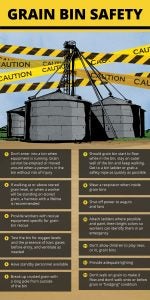Twenty seconds is roughly how long it takes for a grown man to become entrapped in a grain bin — that speed and the fear such a situation creates can make things go from bad to worse.
It’s long been known that grain bins are one of the biggest safety hazards for farmers who work in and around them. Serious and life threatening dangers lurk throughout grain facilities, so it is imperative that farmers and workers are aware of these threats in order to protect themselves from serious injury.

Hazards of Grain Bins
Engulfing and suffocation are major hazards. This is cause by many things, as Illinois Extension points out. One of those being that bins have an opening in the center where grain is pulled from, so when the door is opened and grain is being pulled out, the grain on the inside is pulled down. Workers in the bins can become engulfed and suffocated in mere moments. Alternatively, if a worker is pulling grain that is vertically crusted inside the bin, this can cause an “avalanche” of grain that can also engulf and suffocate. Grain that is crusted on the surface can create holes underneath, called bridging; an unbeknownst farmer can climb into the bin without seeing these voids and fall under the surface.
It is important to note that grain wagons act in the same way that bins do, and can cause harm to weaker individuals, like children, who can’t lift themselves out of the wagon.
Any time you enter a grain bin, be aware of constantly changing conditions and possible hazards — like lowered oxygen levels and toxic gases — all which can cause serious injury or death. Toxic gases can present themselves from fumigants that are used to prevent insect infestation while grain is stored in bins. It is recommended to wear appropriate respirators when the aforementioned situations cannot be avoided.
An unintentional cause of death occurs when coworkers try to save a person from the bins in an accident. Due to grain being more resistant and having a strong pulling force, rescuers are discouraged from any attempts to save their coworker. Instead, OSHA recommends having a rescue system designed and built.
Markie Hageman majored in agribusiness at Fort Hays State University. She is actively involved in her state Cattlemen’s Association, Young Farmers chapter, and National Cattlemen’s Beef Association. Her AGDAILY.com articles can be found here.



